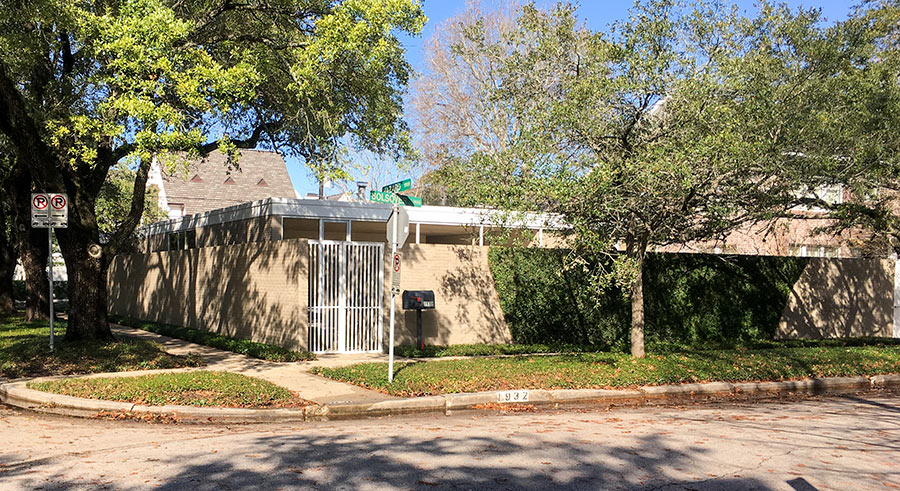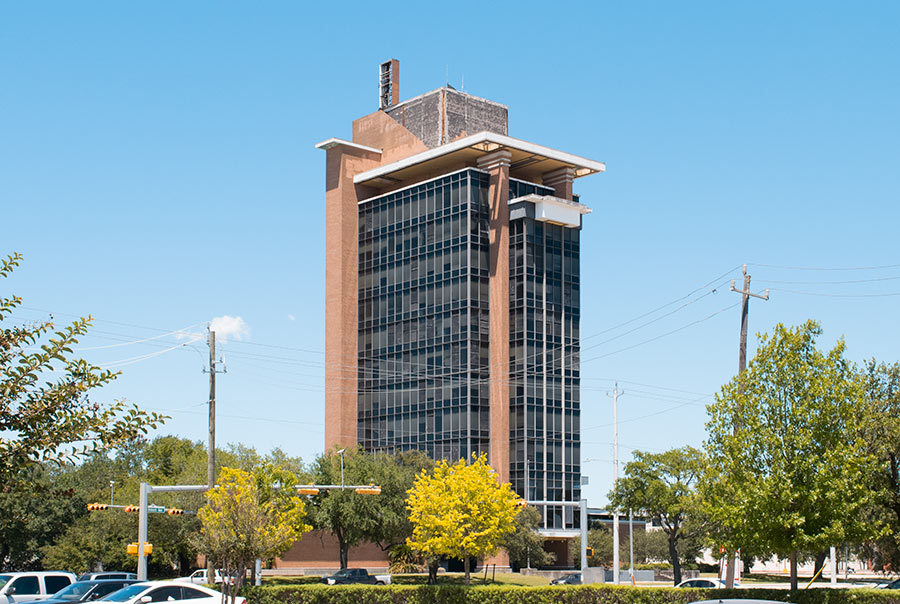ARCHITECTS WITH A LITTLE MORE TIME ON THEIR HANDS A dramatic reduction in plans for new commercial construction — coupled with the Texas legislature’s failure to renew funding for higher education projects — resulted in “about 15 employees” losing their jobs at Kirksey last week, writes Nancy Sarnoff. Also mentioned in passing: earlier cutbacks at EDI Architecture, BNIM, and Gensler. Now that a lot more of you have time to write in, tell us: Are there any other layoffs or related stories we should be mentioning here? [Prime Property; previously on Swamplot]




No loss felt by me. Many of the architecture and construction firms lobby heavily in school districts to build things that are completely unwarranted.
Just ask people up in the Klein ISD area about waste.
Cy-Fair ISD is a bad one also at wasting money on building things not needed.
Well, It’s a relief to know that people losing their jobs is no skin off your back. Congratulations.
Well, many of the jobs were generated from projects that are a waste of school district money.
No one is EVER guaranteed or deserves a job. Your job there from earning it and the need for your work. If your work is not needed, you should no longer have a job. The same thing happened across the board in engineer firms last year. There is still some downsizing this year.
Those firms listed don’t just do projects for local school districts. The architecture field is hurting in all sectors. I think everyone understands that. We all understand the economic realities of the situation. However, it doesn’t help anybody for you to announce that it’s fine with you that people got laid off yesterday.
kjb needs an architect to design him a heart; or at least a passageway to his. :)
Ok,
The people running Kirksey should all have huge hearts and never lay off anybody!!! Let’s see how long the whole business stays operating.
The company I work for has laid off almost 100 people in the last year. That’s just under 50% of the company. No one has had pay raises and senior staff took pay cuts. In the end, its either 100 people were laid off or all 230 employees when the company goes under.
Many of the employees where good at what they do, but were duplicate positions when they they were here.
It sucks. Some were close friends. I still feel for the people that lost their jobs, but there’s a reality.
The people running Kirksey should all have huge hearts and never lay off anybody!!! Let’s see how long the whole business stays operating.
This is not what I’m suggesting. Go back and read what I posted. I said I understand the economic realities of the situation.
It sucks. Some were close friends. I still feel for the people that lost their jobs, but there’s a reality.
Exactly my point! That’s why there’s no profit in your posting the completely irrelevant fact that these layoff didn’t hurt you any. They hurt somebody and those people couldn’t give a flying fig about how it affected you.
(From the Sarnoff post)
Comments
Can we call architecture a profession instead of an industry?
Posted by: Paul at January 17, 2010 06:44 PM
Let me correct it for everyone: ‘Can we call architecture a HOBBY instead of an industry?’
Listen guys,
No one here really knows what went down exactly. All you are reading is about the lay-off. We have no idea what events took place prior to the lay-off, and it is none of our business. We have no idea what the management did to prolong a lay-off, and the measures taken to prevent the lay-off.
I have been in architecture for over 11 years; that is not much compared to most in the community, but I have been through the economic cycles. I was employed with EDI when they lay-offs began in 2008. Over the course of that year and into 2009, I was the last of my group to leave. I can honestly tell you that management did everything in their power to keep staff.
The principals were not taking a salary at all, and the staff took a 20% paycut for over a year.
The principals in the firm spoke directly to the staff, and kept everyone updated on the firm status.
Brit Perkins, a vice president and principal with EDI, was very caring and concerned about his staff; and it was evident with the steps and measures he took to hold onto his staff until new assignments came in, or reactivated.
The moral of the story is that no one knows if the projects were to blame at Kirksey, and it is not really that important.
What should the architects that are without a job do during this downtime; take advantage of the situation! All should work on IDP, get licensed, become a LEED AP, and come back to work with higher crudentials than before.
We can all hope and pray that the economy turns around for all careers and architecture will come back strong and steady again. Keep your chin up, think positive, and be ready for success!
C. Smith speaks to a greater point in his second to last sentence.
Getting laid off should be looked at as an opportunity. When layoffs were flying around where I work, I had to sit back and think what the hell I would do if the all of a sudden I had no job.
Credentials, education, certifications and even just keeping your resume and business contacts/clients list update. Also, don’t burn bridges within your industry. You never know who you’ll be asking for work.
Thanks for the comment C. Smith, but speaking as a firm principal, I can tell you (most likely) what happened. Cashflow took a big dive, (or was about to take a big dive), as the pipeline for work emptied out. Period. Bank lending is at a standstill right now which pretty much means that most private sector work is kaput. Competition for public sector work is tighter than I’ve ever seen in all my years of doing this. A/E RFQ’s for higher education are getting 30-40 responses in some instances. Tax revenues are down, which is contributing to a drastic reduction in capital expenditures by the public sector. The jobs that we have gotten recently have required us to beat out 25 other teams, many just as qualified as us. If the projects stop coming in, most firms if they are lucky have cash reserves to carry staff for 2-4 weeks max until the layoffs need to begin.
Kirksey’s big thing for the last 10 years has been to be the Green with a capital ‘G’ architect. Brian Malarky has done a great job of leading this effort and I have a great deal of respect for the visibility that he has brought to Green Architecture. I figured that if anything was going to save Kirksey in the recession it would be their extreme commitment to sustainability. The market obviously has other ideas.
Hey C. Smith,
How do you work on IDP when you’re unemployed? Don’t you have to be under full-time supervision of a licensed architect (or, to limited degree, a licensed engineer)for work hours to qualify?
I am not attempting to assume what the struggles are that Kirksey is experiencing, my point is that it is not anyones’ business what their struggles are.
Sustainability is a hard sell, especially in times like these. I think the smart strategy in times like these are to be as diverse as possible, and most importantly, be competitive. Fortunately for Kirksey, they are a very diverse firm, and I am hopefull that their revenue will return and things get back to a comfortable level again.
Every firm is down considerably, it is not a secret. My point earlier is that the architects that are without employment should take advantage and get their crudentials taken care of, and be ready to come back to work as a better asset to the firm.
i’m an architect. the profession has been gutted by this down-turn. it’s sad to hear about even more layoffs at kirksey; i was hoping the situation had stabilized and things would begin to turn around. for those of us in our 40’s and 50’s, it’s too late to transition. but younger people should seriously consider alternate or plan b professions while they still can.
Reply to D:
I have considered that, and have done just that! I applied to nursing school last summer, and recieved a full grant for school. If people are considering a different career and have a desire to go back to school; now is the time. It is very easy for people to get grants to go back to school. I just started my second semester (21.0 hours), and have three more semesters to complete the RN program.
I still enjoy architecture very much, and still want to stay current with the software developments. I hope that on my days off, I can still do projects from home, or help out at the previous firms I used to be with.
i believe everyone willing to work hard does indeed ‘deserve a job’. and it’s tough to have to have to tell a good employee that he or she no longer has a job.
Being one of the former Kirksey employees that was laid off, I have a unique perspective on the firm’s situation. First off, it was not around 15 people but exactly 19 people.
Although Kirksey has historically been most notable for its commercial projects and most recently its Eco-Services team experiences impressive growth, I felt that their were two factor’s that let to the firm’s current downturn. Market trends (for sure, but not entirely to blame) and marketing/management.
While the market was surely down in the commercial sector due to developers unable to secure financing, in the other market segments (mainly Higher Ed. and Healthcare) was still experiencing moderate project volumes. During my brief tenure at Kirksey, we saw that the commercial and hospitality team experience months without any work or new projects. However, it was interesting that during this latest layoff, their team relatively stayed intact and that the layoff were from the other teams (even teams that were really busy).
From a marketing stand point, in these recessionary times, small and medium sized firms seems to withstand better than larger firms. Because of its large overhead, Kirksey went after what seemed to be mainly large projects in the RFP/RFQ process in terms of much more competitors. If we get the large project, great, everyone in the firm is busy. However, it is much more difficult to land projects when you are competing with 20-30 other firms, many just as qualified from out-of-town. In addition, what Kirksey did not seem to understand was that specifically for Science+Technology, Healthcare, and maybe K-12 projects, you need to develop and market these teams as one that specialized experts in their fields, not “We’re Kirksey, we are jack-of-all trades we try to do everything architectural firm. Therefore, their portfolio includes a bunch of random different building types but not much experience or knowledge in each type (with the exception of commercial office buildings). In addition, Kirksey routinely shuffles staff from other teams to perform the work. Since there is a huge learning curve of non-experienced staff working on a complex project type (i.e. healthcare, research labs, etc.), their rates of mistakes and screw ups seemed very high among other similar architectural firms. If I am a hospital administrator, why would I hire Kirksey to work on my ICU wing or MRI suite if knowing that I will have staff who normally design schools or country clubs vs. firms that focuses only on healthcare.
Finally, the point regarding management. Kirksey has 10 different teams and based on their website has 17 V.P.s. That is almost 2 V.P.s per team, where the main role of each team V.P. is to market and get jobs. However, during the layoff, none of the V.P.s were in danger of losing their jobs (it’s always the little people doing the work that gets the ac first). If the V.P.’s are not getting jobs or the market conditions are slow, does it merit to keep that many V.P.’s? The company structure was alittle top-heavy to begin with and with the lay-offs of staff and not V.P.s, the % of leadership just makes the ship even heavier. Sometime I feel that architecture is still the good old boys club with the important thing being who you know, not what you know.
I have read similar posts over the last year and a half, both on local and national architecture forums. It amazes me how consistently everyone takes layoffs so personally, and looks for fault within the firm, or within the profession. All architecture firms have flaws, but they generally manage to make money in a decent economy. Read the paper, watch the news – we are experiencing the worst economic crisis in 80 years! These layoffs are happening because the work simply isn’t there. The big projects aren’t happening. There is not enough for everyone to do. And it’s the same in Portland, Las Vegas, Orlando, San Diego – everywhere you look, architecture firms are downsizing or going out of business. During the rapid economic expansion of 2005 to 2008, firms grew, increased salaries, and had a hard time finding qualified staff. Now some of those firms are hemmorhaging money, and they have no choice but to lay folks off.
I have great sympathy for young folks with no savings who find themselves without a job. It’s a tough road. But I’m also glad I’m not a struggling firm owner whose signature is on the company’s loans!